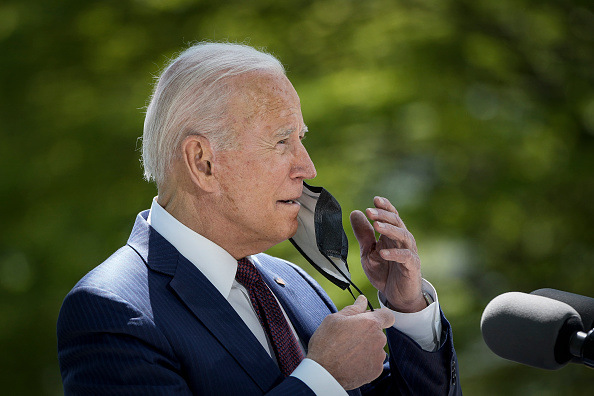President Joe Biden significantly increased the United States’ commitment to reduce greenhouse gas emissions under the Paris climate agreement, at a two-day Earth Day virtual summit attended by 40 international leaders, hosted by Biden.
Biden opened the climate summit by committing the United States to cutting its greenhouse gas emissions by 50 percent to 52 percent below its 2005 levels by 2030. This is almost double the 26 percent to 28 percent emissions reduction by 2025 promised by the Obama administration when the agreement was negotiated in 2015.
Biden established even more ambitious emission reduction goals over the longer term, saying the U.S. electric power sector would produce “net-zero” emissions by 2050 and that the nation would move to it’s personal and public transportation fleet to all electric vehicles.
Big Government, Big Jobs
We need to save the earth from climate change while creating a just environment and an economy build on green jobs, Biden said in his Earth Day Proclamation.
“In recent years, climate change has upended the lives of millions of Americans,” said Biden. “That is why my Administration is advancing the most ambitious climate agenda in our Nation’s history.
“Our clean energy plan will create millions of good-paying union jobs, ensure our economic competitiveness, and improve the health and security of communities across America,” Biden said. “By making those investments and putting millions of Americans to work, the United States will be able to cut our greenhouse gas emissions in half by 2030.”
Promoting International Climate Cooperation
Biden’s opening statement at the summit noted climate change is an international problem, which can’t be solved by any one country alone. As a result, most of the climate initiatives Biden discussed at the summit involved programs to be developed in conjunction with other countries, with large doses of financing from the United States.
Among the new multinational programs the Biden administration proposes creating are: partnering with Canada on a Greening Government Initiative; establishing a Net-Zero Producers Forum together with the energy ministries from Canada, Norway, Qatar, and Saudi Arabia; establishing a U.S.-India Climate and Clean Energy Agenda 2030 Partnership; scaling-up technical assistance to countries participating in the Renewable Energy for Latin America and the Caribbean initiative; and building a multinational “clean energy mineral supply chain,” through the Energy Resource Governance Initiative, a multinational effort founded by Australia, Botswana, Canada, Peru, and the United States. Biden also committed the U.S. to working to reduce international shipping and aviation emissions, while creating a zero-emissions transportation revolution in the United States.
U.S. Taxpayer Funding
Each of these efforts require funding, which is at the core of Biden’s international finance plans. In order to encourage developing countries, to fight climate change as they pursue economic growth, the Biden administration is directing most of the U.S international development dollars to the development and deployment of technologies that produce net zero emissions of greenhouse gases.
For example, Biden directs the U.S. International Development Finance Corporation (DFC) to achieve a net zero investment portfolio by 2040. As an interim step the DFC is directed to ensure a minimum one-third of all its new investments have a “climate nexus” beginning in 2023 fiscal year. In addition, Biden has directed the U.S. Millennium Finance Corporation to “address climate change challenges across its investment portfolio and business operations … over the next five years, commit[ing] that more than 50 percent of its program funding will go to climate-related investments … promot[ing] low-carbon economic development, [to] help countries transition away from fossil fuels, and maintain a coal-free policy across its portfolio of grants.”
To ensure sufficient funding is available for these and the administration’s other international climate programs, Biden is committing two to three times the climate funding spent under President Obama.
“The United States intends to double by 2024 our annual public climate finance to developing countries relative to the average level during the second half of the Obama-Biden Administration (FY 2013-2016),” says Biden’s Earth Day fact sheet. “As part of this goal, the United States intends to triple its adaptation finance by 2024.”
‘Renewable Energy … a Disaster’
Global examples prove Biden’s climate initiatives will, in fact, exacerbate environmental problems in the United States and around the world, says Craig Rucker, president of the Committee for a Constructive Tomorrow, which partners with The Heartland Institute publish Environment & Climate News.
“Moving to an economy that relies principally on renewable energy has been a disaster everywhere it has been tried,” said Rucker. “From blackouts in Australia, to the decimation of birds in California, to soaring electricity prices in Germany, the impacts have been devastating to both the economy and environment.
“Biden’s push to expand the use of renewables and “decarbonize” our energy infrastructure will only exacerbate these problems in the U.S. and globally,” Rucker said.
Biden’s climate plans will bankrupt future generations but do nothing to prevent climate change, says meteorologist Anthony Watts, a senior fellow with The Heartland Institute.
“A worldwide experiment was conducted on carbon dioxide emissions reduction when the world shut down a good portion of its economy due to COVID-19,” Watts said. “Despite large drops in emissions worldwide, carbon dioxide in the atmosphere continued to rise, there wasn’t even a blip of reduction.
Somehow Biden and his advisors think they can accomplish what the year of lockdown did not, by making huge expenditures that will haunt our grandchildren,” Watts said. “To say these misguided climate plans are insane would be an understatement.”
H. Sterling Burnett, Ph.D. (hsburnett@heartland.org) is the managing editor of Environment & Climate News.
